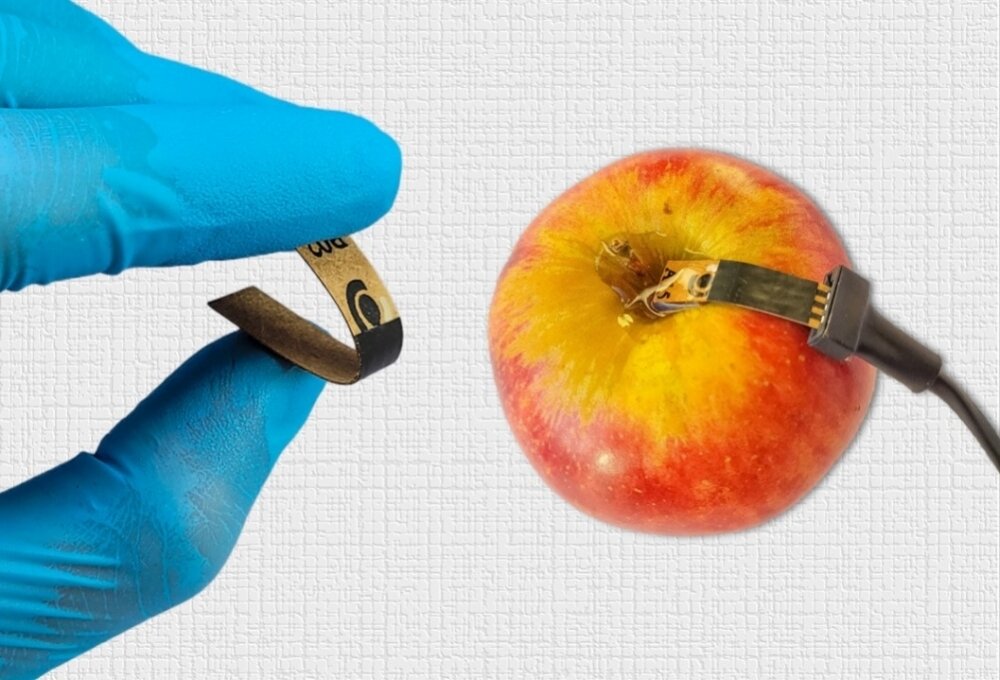
via Phys.org
A new polymer-based, solid-state transistor can more sensitively detect a weed killer in drinking water than existing hydrogel-based fluorescence sensor chips.
The details were published in Chemistry-A European Journal.
The sensor is a specially designed organic thin-film transistor based on semiconducting molecules of carboxylate-functionalized polythiophene (P3CPT). What’s special about this particular device is that, unlike other conjugated polymer-based sensors, this one is a solid-state device that can conduct an electric current when placed inside a fluid.
The device, designed by Tsuyoshi Minami of The University of Tokyo‘s Institute of Industrial Science and colleagues, works by adding copper ions, which bind to the P3CPT molecules. When the device is placed in water that contains even the smallest amount of the herbicide glyphosate, the copper ions leave the P3CPT molecules to attach to the glyphosate molecules. This causes a detectable reduction in the flow of electric current through the device. Glyphosate is a commonly used weed killer in agriculture, and there are concerns that its presence in drinking water can be harmful to human health.
The scientists found that the device was so sensitive that it could detect as low as 0.26 parts per million of glyphosate in drinking water. The team compared their new device to a conventional fluorescence sensor chip, which was only capable of detecting down to 0.95 parts per million of glyphosate. To put this into perspective, the maximum allowable amount of glyphosate in drinking water, according to the United States Environmental Protection Agency, is 0.7 parts per million.
The scientists believe that the sensitivity of their device boils down to interactions occurring within individual polymer molecules and between neighbouring ones. Commonly used fluorescence sensors depend solely on interactions occurring within individual molecules.
“Our device could be a novel solid-state platform for sensing target molecules in aqueous media,” says Minami. The researchers are currently working on further developing their polythiophene-based sensors.
The Latest Updates from Bing News & Google News
Go deeper with Bing News on:
Solid-state transistor sensor
- Best external solid-state drives 2024
External solid-state drives (SSD) have firmly taken over from portable hard disk drives as the preferred means of PC storage, offering far better reliability, performance, and portability than ...
- 15 Companies Relentlessly Working On Solid State Batteries
Solid-state battery technology is being hailed as a potential game-changer for the electric vehicle (EV) industry. It promises significant advantages over traditional lithium-ion batteries ...
- Solid-State Batteries And Motorcycles: Everything We Know So Far
We run down all the information on it. Solid-state batteries offer higher energy density and durability compared to current technology, potentially revolutionizing electric motorcycles.
- Solid State expects to report “record year”
Technology manufacturer Solid State believes it will report results ahead of consensus expectations for what it describes as a "record year". An update to the London Stock Exchange said revenues and ...
- A advance in solid-state electrolytes for all-solid-state batteries: Twice the quality with streamlined processes
This technology, focused on the "size-controlled wet-chemical synthesis of solid-state electrolytes (sulfide superionic conductors)," not only slashes the processing time and cost by over fifty ...
Go deeper with Google Headlines on:
Solid-state transistor sensor
[google_news title=”” keyword=”solid-state transistor sensor” num_posts=”5″ blurb_length=”0″ show_thumb=”left”]
Go deeper with Bing News on:
Solid-state platform for sensing
- Samsung Galaxy Book4 Ultra Review
Samsung's Galaxy Book4 Ultra is a powerful contender in the 16-inch laptop arena, but it's costly and displays in 1800p instead of the 4K resolution found in cheaper alternatives.
- GA-ASI invests in upgrading EagleEye radar with AESA antenna
A working lab prototype of the active electronically scanned array (AESA) component is expected to be ready by the end of the current year.
- Dell Inspiron 14 Plus (7440) Review
Dell's Inspiron 14 Plus is a better value than its XPS 14, but not quite the best in a crowded pack of ultraportables and other lightweights.
- What is Snapdragon X Plus? A look at Qualcomm's more affordable Arm laptop processor.
Qualcomm has unveiled the Snapdragon X Plus SoC, a more affordable alternative to the X Elite. Both chips are made for Windows on Arm laptops, and they're expected to revolutionize the space when they ...
- Filtronic secures partnership with SpaceX for Starlink
British mmWave firm Filtronic has signed a strategic partnership and commercial agreement with SpaceX, a specialist in the Low Earth Orbit (LEO) market.
Go deeper with Google Headlines on:
Solid-state platform for sensing
[google_news title=”” keyword=”solid-state platform for sensing” num_posts=”5″ blurb_length=”0″ show_thumb=”left”]










